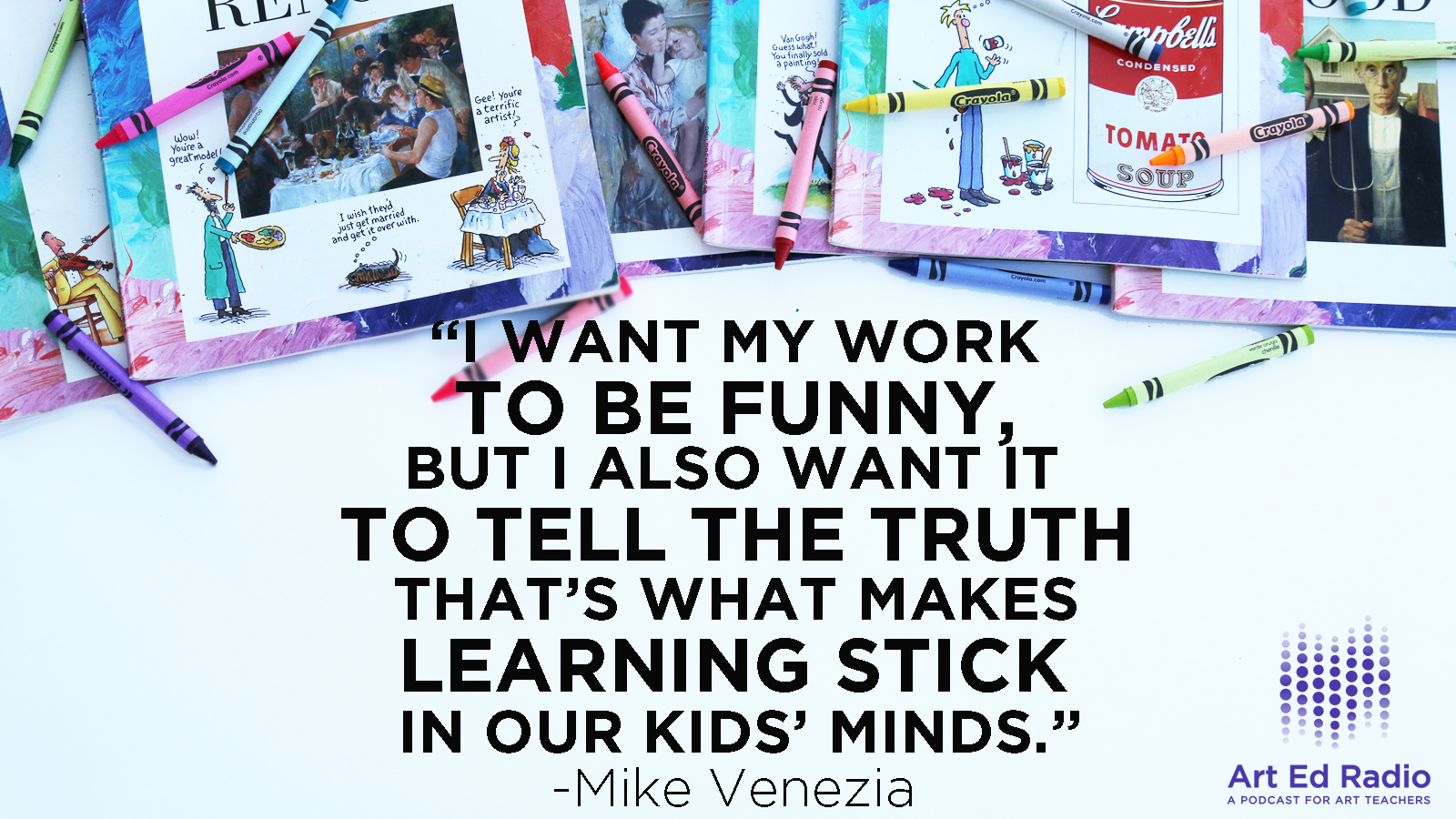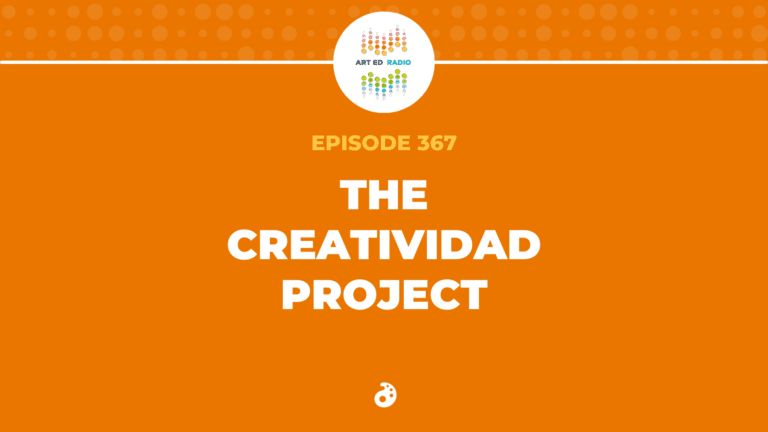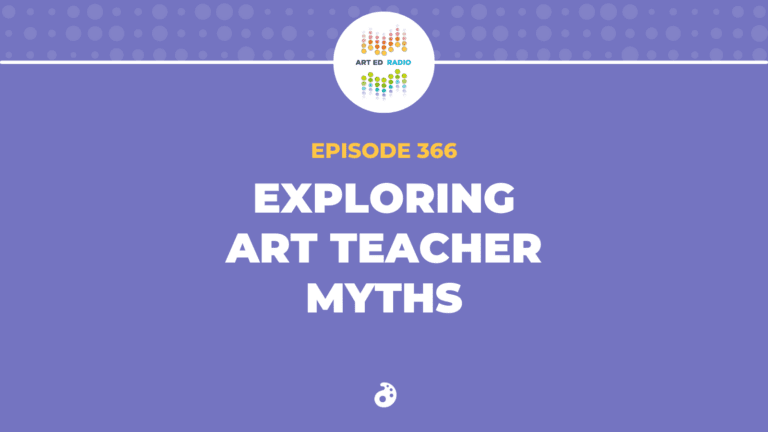Tim had the chance to sit down with author and illustrator Mike Venezia, whose “Getting to Know” series of books are in art rooms around the world. Mike has a great understanding of–and appreciation for–art teachers, and what we do on an everyday basis. This appreciation led to a meaningful and inspirational conversation. Listen as Tim asks Mike about Inspiration and education in art, and how he turned it into a career (3:00), his beginning as an author and illustrator (6:15), and his working methodology when creativity strikes (15:30). Full episode transcript below.
If you want to hear even more from Mike, he will be one of the featured speakers at Art Ed Now, the 2017 Winter Online Conference for Art Teachers. Check out the entire lineup of presenters and register today!
Resources and Links:
- Check out Mike’s website, which features a great bio and all of his work!
- Take a look at this awesome review of Mike’s series of books!
- Here are a couple more ideas from AOE to make Art History engaging and enjoyable:

Transcript
Welcome to Art Ed Radio, the podcast for art teachers. This show is produced by the Art Of Education, and I’m your host, Tim Bogatz.
One of the best things that we can do for our students is to create an environment that allows them to have a positive experience with art. We make things fun, we make things meaningful. My guest today shares a lot of those sentiments. Even though he’s not an art teacher his work has impacted art teachers and students across the country for over 20 years. It is Mike Venezia, author of the Getting To Know series. He has written and illustrated over 120 books. His series of Getting To Know The World’s Greatest Artists have been a staple in art rooms everywhere.
On a personal note I am really thrilled to do this interview. I have the chance to talk to Mike because he’s one of our featured presenters at the Art Ed Now conference on February 18th. In his presentation he’s going to give you a look at what he does as an author and an illustrator, and he’s going to talk about what an important role art teachers play in the lives of our students. It’s going to be amazing. I really have no doubt about that. You will not want to miss it. If you’re interested you can go to artednow.com to check it out, get more information about Mike and get more information about the conference.
Back to the interview. Mike worked in advertising for a long time before he started writing and illustrating books but he definitely knows his art. He earned his BFA from the Art Institute of Chicago, plus there’s that little detail of him researching enough art history to last a lifetime. He and I have a lot to talk about. I want to know about his favorite artist, where he draws his inspiration and his creative process. I want to talk to him about his love for art of course, but also about his love for art teachers because he really appreciates what we do in our classroom and it really is a genuine appreciation.
He gets what we do and he is honestly grateful that his books are able to play such an important role in making art fun and enjoyable and meaningful for our kids. It’s a lot to cover I know, and I know everyone is ready to hear what Mike has to say so let’s go ahead and get the interview started.
Mike thank you for joining me. How are you today?
Mike: I’m fine, thank you. Glad to be able to do this interview with you.
Tim: We are very glad to have you. I guess I’ll start off with a little bit about your story. I know a lot of art teachers listening to this podcast have loved all of your books and all your work but don’t know as much about you as a professional or as an artist. Can you talk a little bit about your background and your journey as to where you are today?
Mike: Sure. I would say in the very beginning I owe a lot to the encouragement of my parents. They were always very supportive in my endeavor to be an artist. Secondly all the wonderful art teachers I had through my school career. With that I went towards that track.
I remember in school I was a pretty good artist, I got the biggest kick out of my school career was to try to get my classmates to laugh. I would do little cartoons whenever there was an opportunity. For example if a teacher said something that might be able to be taken two ways, I would do a little cartoon and pass it around, and somebody laughed, it was a great, great day for me. Didn’t make for a great beginning as a student but later in life it kind of paid off.
Then I would continue those type of things even in high school and my college at the Art Institute of Chicago. It was a way for me to have an exciting fun day. My high school art teachers were very supportive of me and encouraged me to try out for the school of the Art Institute of Chicago, which I did. It was a great decision for me, I went there for four years and some of the things that I was able to do there was going to the museum whenever I wanted. Every morning they would open the museum up to the students, so you could go through this big door at 8:00 in the morning before any of the public showed up and have the whole museum to yourself.
I learned a lot by studying my favorite artists on my own time, day after day, two or three times a week for four years, so it’s a great thing. Early on too my parents, they always had reproductions of great paintings up on the wall. Early on I could see Rembrandts, Monets, Renoirs and it got me excited as a young boy, six, seven, eight, nine years old. The whole thing came together after the Art Institute experience, I went into a career in advertising as an art director. That’s where I could kind of use my humor and visual ideas to turn into a career.
Tim: Yeah, that’s really cool. Then as you’re working in advertising I know you started working on the Getting To Know series. If I can ask, what was your original inspiration for the Getting To Know The Great Artists series? How did you get started writing and illustrating those?
Mike: A few years before I began that I thought it might be an interesting idea to try to do a children’s book of some kind. My ad agency, which was a Leo Burnett company, was probably the largest ad agency at the time, was filled with super creative people who would do things on the side so to speak. Many of them went on to become super famous. For instance John Hughes who did a ton of really major films during the 80s and 90s was just down the hall from me. People who ended on Saturday Night Live like Father Guido Sarducci who was Don Novello and Tim Kazurinsky.
They were all going to Second City and they were all doing things that fell with their advertising ideas. You could explore different areas of things. I thought, well, maybe a children’s book would work. I tried a couple of children’s books but then when my kids were in school they had very minimal art, if any, education opportunities. Some of the moms would get together and they’d do a program called Art Smart or something like that, Art Moms.
My wife was one of those and she was telling me how hard it is to get material for kids, first through sixth grade, that would make any sense. She would send away to the National Gallery of Art and they would send a huge reel of 16 millimeter film that was faded. It was like an art lecture that went on for an hour and everybody was falling asleep. I did some posters talking about maybe Picasso or some of the big name artists. I thought, “Why don’t they have books for children on art? There’s books for maybe seventh and eighth graders, maybe high school kids, but nothing for the younger ones.
Since I had had contact with a publisher for my previous books I just approached them one day, I worked out a couple of dummy books, one on Picasso, one on Rembrandt. They eventually went with those. I never expected it to turn out like it did. I thought maybe I’d be lucky if I could get four books or six books, and then all of a sudden I have 50 books. It was a great surprise to me. I was able to do these because in advertising you have to really be disciplined with timelines and getting things done on time, so I always had that kind of disciplines and whenever I was flying somewhere to do a commercial, say in California, I would use the time on the airplane or after a commercial shoot in my hotel room to work on my books. It kept me busy but it was the enjoyable part of my art career thing.
Tim: Yeah. Yeah, that’s really cool. Now a little bit earlier you talked about touring the Art Institute and your parents’ home with Rembrandt and Monet and all of these artists, but do you have a particular favorite artist or a couple artists that you’ve written books about? Who are the artists I guess that you really admire or that are inspiring to you?
Mike: Yeah I do. I do school talks occasionally and that’s one of the questions that comes up quite often, “Who’s your favorite artist?” I always tell the kids that it happens to be the one that I’m working on at the moment. The reason is because I feel like I’m getting to know this person. I learn about their childhood and their family and all the trials they went through. You feel a real closeness with them.
If I had to pick a couple I would say Edward Hopper is one of my all time favorites. I could stand in front the Nighthawks and some of his other paintings and try to imagine what’s going on in that background. What kind of a neighborhood is that? Who are those people at the counter in the café, in the Nighthawks? Jackson Pollock is one of my all time favorites because I think he’s a major, major artist, but I think in order to really appreciate him you have to stand in front of one his amazing paintings because when you do that if you take the time, all of a sudden you feel engulfed in light and energy, which is kind of what he wanted to do. All those splotches and stains of paint and everything almost become alive in an energy kind of way.
There’s artists that I haven’t written about that I’d really like to but sometimes securing rights for their work, especially 20th century artists, has become too difficult, so my publisher, which is Scholastic, doesn’t even want to deal with them. I would love to do a book on Kandinsky and Moreau and Hans Hoffman, who is one of my super favorite artists. Again it’s like when I go back and look at these artists when I’m doing my new editions, I get reacquainted with them. We try to go to museums in every city we visit, and especially here in Chicago there’s a number of really great museums to take advantage of.
Tim: Yeah for sure. Yeah you just mentioned this but I know you’re always working on new stuff and you have some new editions of your books that are coming out so can you talk a little bit about the impetus for updating those? Why do you go back and update those? What kind of changes and updates do you make when you go back and do those revised editions?
Mike: I was really happy when Scholastic contacted me because some of the first books I did were as early as 1988, but they’ve been selling steadily and I think what started this off was common poor standards, in that there’s more of a need for nonfiction books. That’s my feeling. What I could do is I could take these older books, and they told me they wanted three new pages in the front and three in the back.
What I decided to do is put in maps of important places in an artist’s life. I really love doing these maps because I’ve always been fascinated with maps. I had a little bit of fun with them, like Mount Vesuvius for instance I’ll have pasta shooting out of it, but it’s in the right place in Italy. I try to keep everything accurate but put fun little icons all over. They always want a timeline, a timeline of the artist’s life, fine. At the end I thought, how about some fun questions and answers? I’ll do questions that have a serious question and then two crazy questions, and then you get the answers on the next page.
Then I try to be more accurate and slightly more serious. Then they added a page of an index and glossary. I think that’s what started it, I have to go back and do all kinds of research again because some of these were done so long ago I got rid of all my notes and books that I used, I donated all of them to the library. It takes up a lot of time doing that but I really enjoy it. Now I’m starting to do some more of my composer books.
Tim: Yeah, I think that’s really cool. I know it takes a ton of research to do all this. You mix that with creativity and all of your strengths playing together. On I guess a personal level for you can you tell people listening to this what a typical in the life would look like for you? Are you one of those nine to five artists that has a set schedule everyday to do your research, your drawing, your writing? Or are you more the type that works whenever inspiration might strike you?
Mike: Yeah, it’s more of the I work when I feel like it, but I also have deadlines that I have to address. If I put too many days off without doing anything I’ll immediately jump into it. If we go to a shopping mall, for instance I have a laptop desk in the car and I’ll just wait for my wife to get done with her shopping at Nordstrom’s and I’ll do all this reading and that type of thing.
Sometimes I’ll go the library where it’s more quiet. I find it the best of all situations because I don’t have to go be somewhere in a meeting, I don’t have to present stuff in front of people, which is what I was always doing in advertising. The meetings were always the thing that would take up half of your day, you could be going to meetings here, there and everywhere and you couldn’t do any work. Now I can just get things done when I want and I enjoy it very much.
Tim: Yeah. That’s awesome. I love that you have the ability to set your own schedule and do your own thing. That’s really, really nice. You talked earlier about your favorite art teachers growing up and talked glowingly about them and how all of this art education has played such a big role in your life. If I can ask you one last question here, we have so many art teachers listening to this, for them aside from your books or just in general what do you think are the best ways to introduce our students to art, introduce them to famous artists? I know you try and make your books a lot of fun so how important is that to you? Do you think that we need to make things fun in order to make those types of learning stick for our students?
Mike: Yes definitely, especially for students such as myself and I know there’s probably a lot of them. I find humor to be the way to get a child’s attention. None of my illustrations are done just to be funny, I always have some way to tie them into reality. For instance in Georgia O’Keeffe, she said that she could remember when she was 18 months old her mother sat her down on a blanket in their dusty driveway in Wisconsin. She looked at the dirt, the soil around her and she wanted to know what it tasted like because she was so inquisitive. She took a handful of dirt and ate it.
I thought, wouldn’t that make a great cartoon, so I have her sitting there contemplating eating dirt with all the farm animals around her and she says “Yeah, I wonder what this dirt stuff tastes like.” A worm say, “Oh it’s great. You’ll love it.” A rabbit says, “I prefer carrots,” and so and so forth. The cartoon is funny but it’s based on a truth. That’s what I have always tried to do, to make things stick in a kid’s mind.
Tim: Yeah, I think that’s great. Yeah, like I said I love all of those illustrations and I love the humor that are in all of your books. That’s great. I think that’s all we have time for today. Mike I want to thank you very much for joining me on this. I know that everybody who’s coming to the Art Ed Now conference will really, really enjoy your talk. I appreciate you, like I said, joining me today. Thank you.
Mike: Okay, thank you.
Tim: That was a great interview and that was a lot of fun. A big thank you to Mike for coming on because I love the chance to be able to talk to an author and an illustrator that has had such a big influence in our classrooms. Like I said, a big thank you to Mike Venezia for being on the show.
Again if you want to hear more and see more from him check out his featured presentation on February 18th at the Art Ed Now online conference. Like I said you can see more about Mike and more about the conference and go ahead and sign up at artednow.com.
I loved everything that he had to say about his inspirations and what continues to inspire him. I loved a lot of those little stories that he told as well, like his early mornings at the Art Institute, the encouragement from his parents, rubbing elbows at his ad agency with Saturday Night Live cast members and sneaking in work whenever and wherever he can. A lot of really entertaining stories. I think what really comes through is Mike’s genuine love for art. I love that he has attempted to share what he loves about art with so many students and that he’s now willing to share it with art teachers as well.
Hopefully we can take some ideas from his approach and get them going in our classrooms because that engagement and fun that he talks about and that good teaching can provide is something that’s really valuable for all of our students. That message of enjoyment and engagement and positive expression can give our students a love of art for a long time to come.
Art Ed Radio is developed, produced and supported by The Art Of Education with audio engineering by Michael Crocker. Please subscribe to Art Ed Radio on iTunes or your favorite podcast app and check out artedradio.com to see all of our old episodes. When you are there you can enter your email address to sign up for the Art Ed Radio mailing list. We send something out every week with some thoughts on the shows, some other quick writings and recommendations for other podcasts, artworks, stories from around the entire world of art. A lot of people it’s the best part of their week so make sure you go sign up for that. Check out artedradio.com. As always thank you for listening.
Magazine articles and podcasts are opinions of professional education contributors and do not necessarily represent the position of the Art of Education University (AOEU) or its academic offerings. Contributors use terms in the way they are most often talked about in the scope of their educational experiences.



